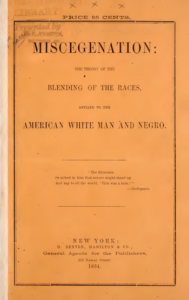
Pamphlet
On this date, the African American Registry discusses American miscegenation.
Shortly before Christmas in 1863, a 72-page pamphlet appeared for sale on newsstands in New York City. It was titled "Miscegenation: The Theory of the Blending of the Races, Applied to the American White Man and Negro." The pamphlet began with details of its title. "Miscegenation" was a word that the author had created, and he explained that he had invented it by combining two Latin words: miscere (meaning "to mix") and genus (meaning "race"). The authors intended to replace the word "amalgamation," which they felt was not scientific enough. The pamphlet gave a social philosophy that, by the racist standards of 1863, was highly inflammatory.
The authors wanted to promote the practice of miscegenation and encourage white and Black people to have children with each other. The real authors were David Goodman Croly, managing editor of the New York World, a staunchly Democratic paper, and George Wakeman, a World reporter. Within months, two Democrats in the 1864 presidential election campaign anonymously issued the same pamphlet, which was later published in the New York Times. During this time, sex across the color line was an obsession of white America, particularly the stereotype of Black men's alleged craving for white women, along with believers in Anglo-Saxon "racial" superiority who feared that "mongrelization" was degenerative.
It is a fact that Black-white sex existed from the beginning of the slave trade in the 15th century, virtually always on the initiative of Europeans who held Africans in their total control. During the infamous Middle Passage between Africa and the New World, Black women and children were allowed mobility on board ships so that white sailors could have unlimited sexual access to them. Sex played a role in the gradual separation of Africans from other indentured servants in Florida and Virginia.
Upon arrival with the unique North American reality of chattel slavery, Black people were legally defined as property. The very first case in this chain was a sexual one: In 1630, Hugh Davis was sentenced by the Virginia court to a whipping "for defiling his body in lying with a Negro." Although a white man was convicted and punished for the act, the case shows the early eroticization of racial differences.
The interracial sexual pattern in the Antebellum South is clear. Because slaves were property, like animals or objects, they had no rights, and all Black women were sexually available to all white men. In addition, the law did not recognize Black marriage and parenthood, and there was no recourse for sexual abuse in the courts, government, church, or press. Virtually every plantation produced children of mixed race: The 1860 federal census classified 588,532 persons as Mulatto. A minuscule number of white fathers recognized their children and provided for them; some parents encouraged the fairest-skinned to run away and hide their racial identity by passing for white. Most mixed-blood slave children worked and were sold like all other slaves.
The white South combined the permissive sexual exploitation of Black women by white men with their fanatic "protection" of white women from Black men. In each case, the ideology was that people of African descent were closer to savagery. Still, the real reason was almost certainly economic: Legally, a child was a slave or free, depending on the mother's status. All white women were free, and nearly all Black women were slaves. The exclusivity of chattel slavery was prohibited in North America (except for New Orleans), and the emergence of mulattos as a distinct third group between Black and white, as existed in the West Indies, Latin America, and South Africa. American slavery was race and color-based, but it would have weakened ideologically and economically if it had allowed any deviation from the one-drop rule, that is, the belief that any Black ancestry made a person Black.
Miscegenation was about marriage as well as sex since sexual relationships were legitimized by marriage. As a result, interracial marriage was prohibited and upheld by the U.S. Supreme Court in Pace v. Alabama (1883). That decision was not overturned until well after the 20th-century Civil Rights Movement had begun, in Loving v. Virginia (1967), when 16 states still had laws prohibiting interracial marriage. Civil rights and voting rights were extended to African Americans before the right was granted to whites and Blacks to marry (and have legitimate sexual relationships) across the color line. In Britain, people of mixed race have been dubbed "the Bridge-generation," with one in 20 children under five classified as `bi-racial.
The number could be similar in America, but classification forms still often feature Black/White fill-in boxes and only now include biracial as an option on various forms. The term miscegenation does not fit well currently. Still, the most widely known example of this practice was probably the relationship between President Thomas Jefferson and his slave, Sally Hemings, in the early 1800s. In November 1998, the British science journal Nature published the results of Dr. Eugene Foster's DNA study of the two. This study has sparked numerous controversies regarding Thomas Jefferson's paternity of Sally Hemings' children. Many people believe that this DNA study, when combined with other historical evidence, resolves the issue.
The Thomas Jefferson Memorial Foundation issued a report in January 2000, concluding that Thomas Jefferson was the father of at least one, and perhaps all, the children of Sally Hemings.